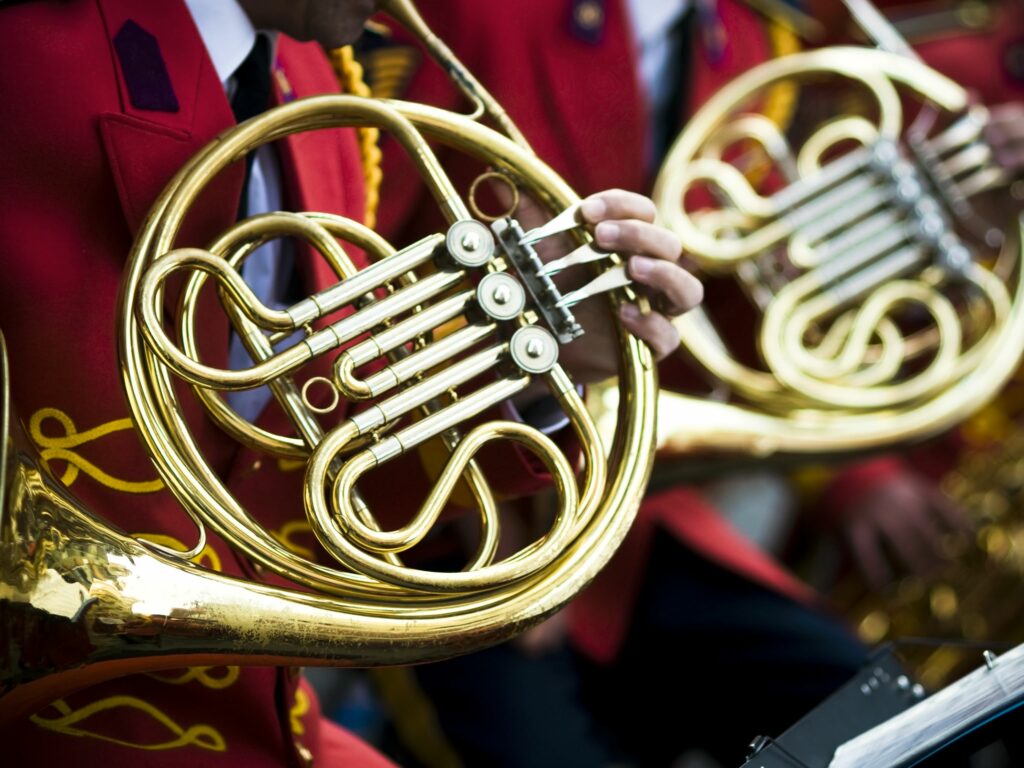- Famous Trombone Players Guide - September 5, 2022
- How to Find the Best Triple French Horns - May 30, 2022
- Best Bach Trumpet Options We Truly Stand By - May 27, 2022
Triple horns can be a great addition to the arsenal of a professional hornist. They add a small length of tubing to the horn, helping make the high register super secure! If you’re thinking about buying one yourself, or if you’re just interested in finding out more about brass instruments, we’ll talk you through what they are, why they’re useful, and how to choose one!
What Is A Triple Horn?
Triple horns might be thought of as a double horn with an extra, shorter length of tubing for playing high notes. If you’re unsure about what a double horn is, check out our Brassnwind guide to double horns!
Often this shorter pipe is pitched in high F (one octave above the normal F side), though some triples have begun using a high Eb side instead. This means that instead of an F/Bb french horn, these are referred to as F/Bb/F alto or F/Bb/Eb alto. Don’t worry, I’ll explain the pros and cons of the high F or high Eb later!
Triple horns have become particularly popular with professional horn players, especially session players, for whom accuracy the first time around is crucial. However, they’re not for everyone, as they are more expensive than a full double, and the design makes compromises to the F and Bb sides of the horn to incorporate the additional shorter tubing. Read on to find out more about if a triple horn is suitable for you!
Who Should Use A Triple Horn?

Triple horns are pretty advanced equipment, unsuitable for beginners as the extra tubing is unnecessary for them, and the added weight and keys can be a bit confusing. If you’re more experienced and regularly playing as a principal horn, in the high register, then a triple horn might be something to consider.
If you play in a marching band and are looking for a good horn for that, a triple horn probably isn’t for you. These are heavy, expensive instruments that are probably a bit overkill for marching bands (not to mention your arms will get tired much quicker than with a double horn).
For the vast majority of players, a double horn is more than enough – it can cover the whole range of the instrument, and is designed to make a great sound on both the F and Bb sides of the horn. For those players that regularly play in the extreme high register of the horn (especially with the exacting demands of contemporary music and film recording sessions), the ease of the high register and added security on the notes on a short tubing can be invaluable.
In these cases, there are two options to have shorter tubing available; alto horns (or descant horns, another name for the same thing), or triple horns. Be sure not to compare alto/descant french horns with ‘alto horns’ – this is another instrument entirely, which is a member of the saxhorn family.
If you’re after the added security of the short tubing (or even just fancy owning one for fun), alto and triple horns can be super useful. Excerpts that are super scary on the full double become much more secure on these instruments. Read on for a comparison of descant horns and triples, before I explain some of the best triple options and how to choose one for you!
Triple Horns vs Descant (Alto) Horns
Triple horns and descant horns are both types of brass instruments that are often used in a similar repertoire, but there’s some nuance to which people tend to prefer. While many professionals own a descant horn, very few choose to own a triple due to the high price.
Descant horns are normally used as a kind of auxiliary instrument (as a backup to a player’s full double, for special high repertoire), whereas triple horns are more commonly used as the day-to-day workhorse instrument by principal horns who play a great variety of repertoire.
Personally, I play around 90% of the time on my double horn. I also own a descant horn that I picked up second hand, as from time to time I’m required to play high classical repertoire at short notice, and it makes it a hell of a lot less scary. I’ve never considered a triple horn for myself, as I love the double and also have the descant as an option.
However, whether you want to consider owning a descant or triple horn is up to you and, if you have the money, each type could certainly be a great option to try. Here’s a breakdown of the pros and cons of each type of instrument!
Descant (alto) Horns

Pros
Light instruments
-
- Descant horns don’t weigh much. They’re just a single Bb horn with an additional smaller side (normally F alto). This means that they’re quite light.
- Light horns are associated with specific playing characteristics. Generally, they’re more responsive, easier to articulate on, and of course less tiring to hold!
Cheaper than a triple horn
-
- Triple horns come in pretty pricey. Descant horns on the other hand require much less material and time to make, so come in around the same price as a full double, if not cheaper.
Fewer compromises in the wrap than a triple
-
- The more lengths of tubing you include in a horn, the more you have to compromise the optimum shape of each length to get them to fit together. For this reason, some players in the past even preferred single Bb or F horns to double horns.
- As a descant horn is just two lengths of tubing combined, there are fewer sound and intonation compromises involved in the construction than a full triple horn.
Cons
Generally less projection than a double or triple horn
-
- This is the flip side of lighter horns – they tend not to project so much
Lighter sound than bigger horns
-
- Descant horns often lack the resonance of full doubles. This means that they generally have a lighter sound, which can break up at louder volumes.
No low F side so lacking in the big symphonic sound
-
- The lack of choice of the low F side is the biggest distinguishing factor between a descant and triple horn. Some horns fill in the ‘missing notes’ that descants lack by using an extra ‘F extension’, which is an added valve that adds length to pitch the horn in F. However, this isn’t the same as having a true F side, so although you can reach all the notes, it doesn’t make the same characteristic sound like a true F side.
Triple Horns
Pros
- All three sides to choose from, whether you need the big sound of the low F side or the versatility of the shorter side
Cons
- More compromises in the wrap than
- Heavy – the weight of all three sides adds up! This also affects the playing characteristics of the horn, as lighter horns are generally more responsive and versatile.
- Expensive – these are the most expensive horns you can buy.
What Is A Compensating Triple Horn?
Compensating triple horns are a different type of horn in which, rather than having three true sides to the horn, there is just an extra length of tubing that ‘compensates’ to make the longer lengths of the horn.
This is pretty confusing to explain, but basically means that instead of having a separate length of tubing for the F side, this length is generated by using the Bb slides and adding shorter lengths of tubing. There are pros and cons to this; it’s a cheaper, lighter way to have the notes of the F side available, but also lacks the true harmonic series and rich sound of the low F side.
If you’d like to know more about this, check out this handy guide from Norman’s music shop, where they explain the science of compensating instruments more fully.
How To Choose a Horn
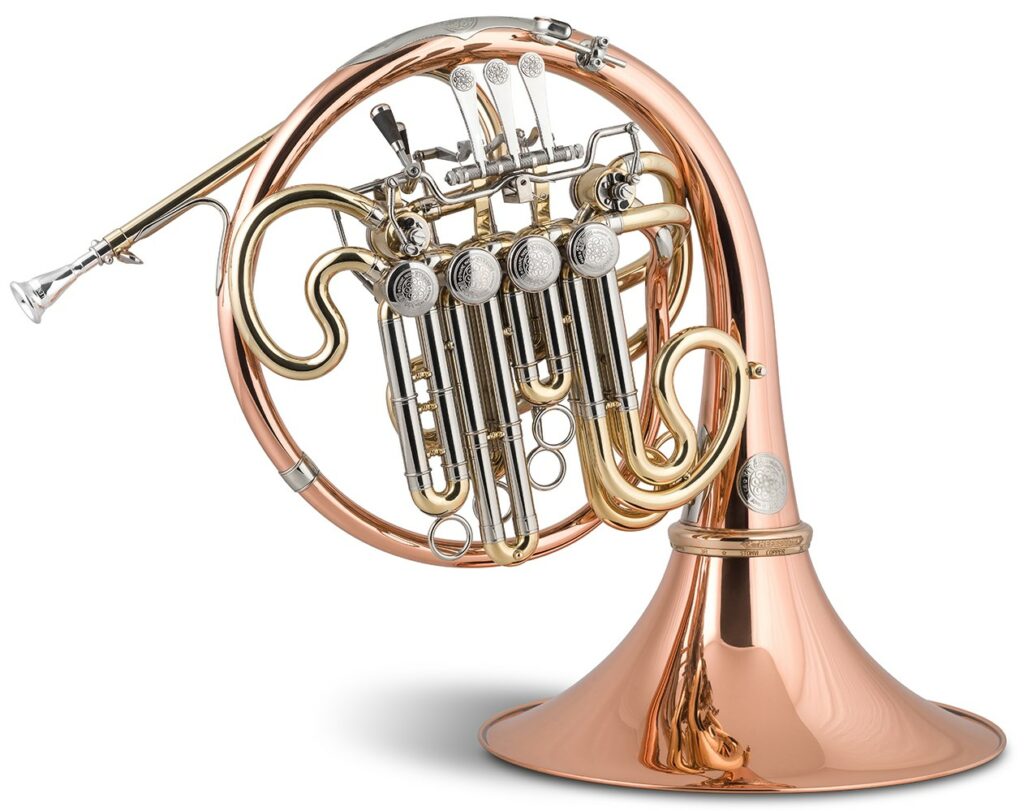
Once you get to choose a triple horn, it’s actually surprisingly simple. There are not so many options out there as with double horns, and they are always flagship models of the brand.
If you’re after a triple on a budget, your only real option is to buy a second-hand instrument. While there are some cheaper triple horns out there, for the same money you could buy a really nice full double or descant horn. It’s worth mentioning that almost all horn players use a full double as their normal horn, so I wouldn’t recommend owning a descant horn as your sole instrument!
Criteria
There are a few criteria that I’d recommend considering when thinking of buying a triple horn. In order of importance, these are; intonation, sound, which lengths of tubing the horn has, the look and feel of the instrument, and the mechanical characteristics of the horn.
Let’s take a look at each of these in detail!
Intonation
With all brass instruments, intonation is the most crucial factor in deciding whether to buy it. If an instrument plays out of tune, it is not worth the money, no matter how good its other characteristics are. With a triple horn, you’ll need to check that all three sides of the horn play in tune, before comparing that they also work with each other.
High horn – Eb/F?
The tubing that the horn uses for the ‘high’ side affects the playing characteristics of the horn. While the high ‘F’ side is a light, versatile pitch that really pops out on the instrument, a high Eb side makes a slightly mellower sound while offering similar playing characteristics.
It’s worth bearing in mind that, while the high F side fingerings are pretty similar to the Bb ones, if you choose a high Eb side you’ll have a new set of fingerings to learn! This is confusing at first, but generally, if you’re good enough for the triple to be worth it, you’ll have no major problems getting used to it after a couple of weeks.
Sound
The sound of the horn is a major factor in choosing a triple horn. While some people like having a descant that makes a light sound suitable for baroque or classical repertoire, a full double horn should be able to make a symphonic sound in all registers of the horn. A triple horn shouldn’t be an option for high register playing, but a horn capable of everything and probably your first choice instrument!
Lots of factors affect the sound of any brass instrument. Different models have different bores, different wraps, different bell sizes, and are made of different materials. Each of these factors affects the overall sound of the instrument.
Material
-
- The material a horn is made out of makes a big difference. The most common options for a triple horn to be made out of are yellow brass or gold brass.
- Yellow brass is normally the default and gives a horn a brighter, exciting sound. The slightly higher copper content of gold brass means that it is slightly heavier, and renowned for a warmer sound.
- Visually, gold brass also gives the horn a darker color.
- Gold brass is a more expensive option than yellow brass.
Finish
-
- Generally, horns come either lacquered or unlacquered. Although the primary purpose of this is to preserve the metal, some people believe that there is a sound difference between unlacquered and lacquered horns. Try options with both to make up your own mind!
Bell size
-
- Many of the horns on this list come with a few options of bell sizes. Larger bell tapers are generally thought to make a warmer sound but require more air to play.
Wrap
-
- Triple horns are distinctive instruments, and every horn on this list has its own distinctive way of fitting the tubing in. This is known as the wrap. Different wraps of horn have different playing characteristics; in particular, this is thought to affect the resistance of the horn (how much air it requires to play), as well as the intonation and sound of the instrument.
Look/feel
While the aesthetic characteristics of a horn (which aren’t too important, but if you have the spare cash can be nice extras) are obvious, It’s a bit more difficult to nail down exactly what makes a horn feel like it does to play. I’ve made this category deliberately vague to be able to talk about a few different things I like about different instruments!
Resistance
-
- I’ve already mentioned how the wrap of the horn can affect the resistance of the instrument. Some players prefer resistant instruments, which are often very accurate in the high register, easy to articulate, and great for quiet playing, while others prefer more open horns that, amongst other characteristics, generally have better low registers and require less air to play at the high volumes required in professional symphony orchestras.
Ergonomics
-
- The setup of the instrument is pretty important, especially on a triple horn which can have up to six different valves. This means you’ll need the horn to be easy to hold and use without causing your body additional stress.
Weight
-
- Triple horns are large instruments, and weight can be a big consideration in choosing one. It’s a common reason that many pro players prefer not to use one.
- The balance of the weight is also important, as you might prefer an instrument weighted slightly differently for the purposes of holding it.
Other factors
String/mechanical valves
-
- Most rotary valves on french horns come with the option of cord linkage or mechanical linkage. Cord linkage is generally more efficient and requires less oil – though with these it’s important to know how to reconnect in the case of string snapping.
- Mechanical valve linkage is a more expensive, more reliable option, though it can be a little noisier sometimes.
Detachable bell
-
- Most horns come with the option of a detachable bell, attached by screw rings, which means you can remove the end to make it more easily transportable in a backpack-style case.
Stopping valve
-
- Many horns come with a stopping valve, which is a short extra valve that lowers the pitch of the horn by the right amount to be able to hand-stop on the Bb side of the horn while using normal fingerings (rather than transposing down a half-step).
- This valve can also be useful as an alternative fingering option.
Best Triple Horn Models
Without further ado, on to some of the best models of triple horn! Of course, there are many more fantastic triple horns out there, but for this article, I’ve focused on the most common makes.
Cornford S3 Compensating Triple Horn
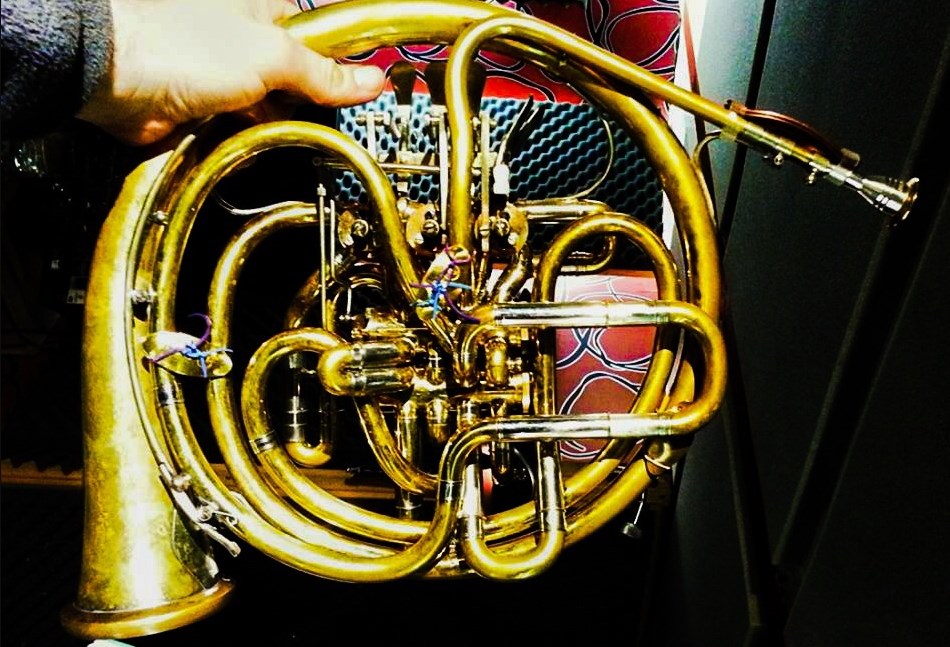
A unique option is the Cornford Compensating Triple Horn, in F/Bb/F alto. This horn has a truly unique wrap, unlike any other horn on the market! The spaghetti appearance is part of its compensating layout, which helps it keep relatively light for a triple while having the whole range of all three sides of the horn.
As a compensating horn, this horn is lighter and cheaper than the other options on this list, at around $9,500. However, this comes at the expense of having a true F side, one of the key benefits of a true triple horn over the cheaper and lighter alto/descant horns available.
Features
- Unique compensating layout
- Yellow Brass
- Detachable Bell as standard
Paxman 75.3
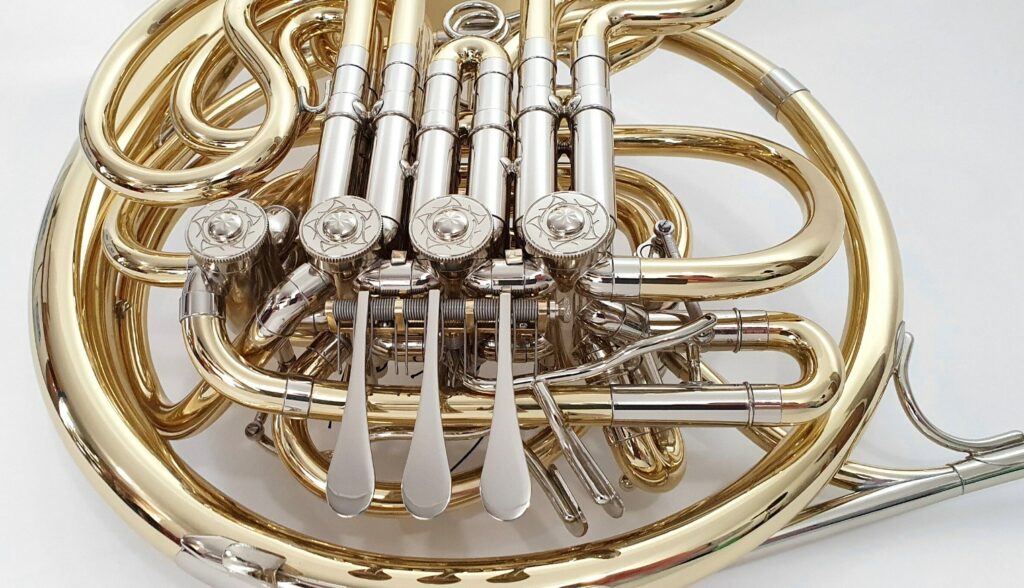
Paxman horns, based in the UK, claim to have produced the world’s first successful triple horn, more than 50 years ago. Today, they continue to lead the way with their triple horns, which are a popular choice with professional players. While in the past these horns have included the models 70 and 80, today the flagship model is the 75.3.
Brand new, the cheapest version of this horn costs $18,600, with the price dependent on optional extras such as metal and finish.
Features
- Paxman Merryweather system, keeping the flow of air consistent
- Dual bore Bb and F slide system
- Optional choice of metals and bell size
- Compact valve section as standard to reduce the weight of the instrument (standard available on request)
Alexander 303

Alexander horns, made in Germany, are incredibly popular across Europe, especially the 103 full double horn which is played by the vast majority of German horn players. Alexander also manufactures a full triple horn, which is known as the 303.
The Alexander 303 costs around $15,000 brand new, dependent on the options selected.
Features
- Choice of metals
- Fully independent slides
- Tuning bit in mouthpiece receiver
- Unique Alexander design
Yamaha 891
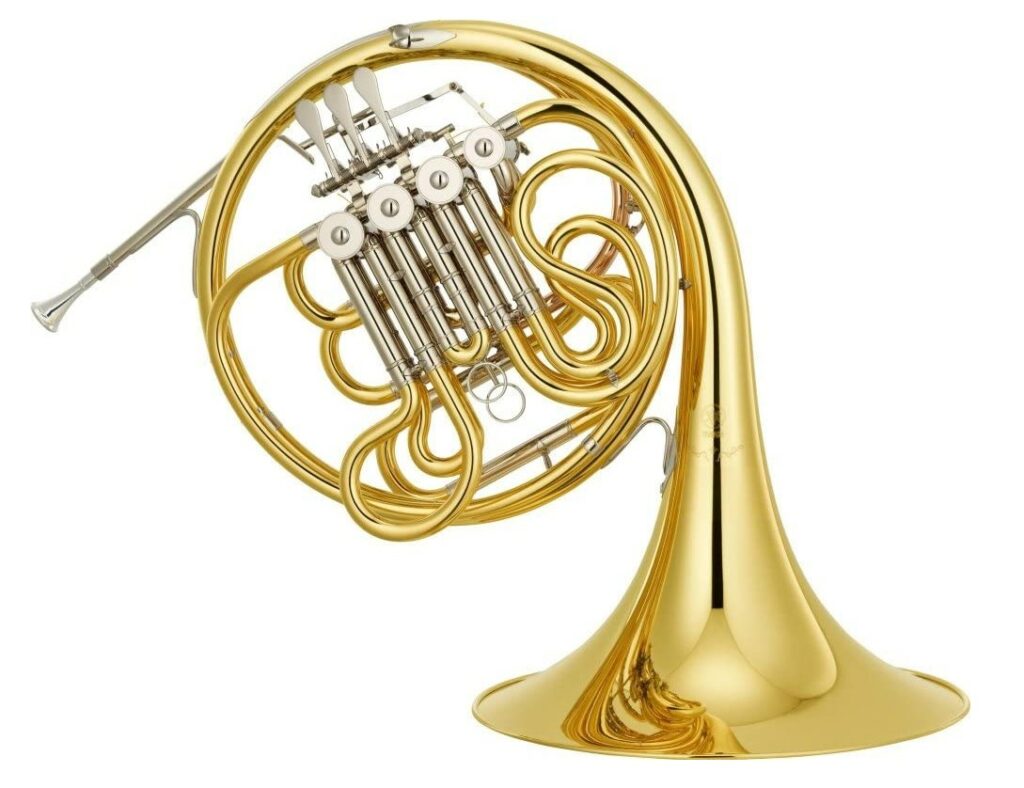
Yamaha is one of the leading manufacturers of brass instruments, producing a whole range of every instrument under the sun! At around $10,000, the Yamaha 891 is actually one of the cheapest good full triple horns on the market. Despite this, it doesn’t sacrifice quality, with all the features that you would expect of a top-quality triple horn.
Features
- Choice of metals
- Fully independent slides
- Tuning bit in mouthpiece receiver
- Yamaha layout
The tone is rich and deep with a solid core. Fixed bell. Leadpipe A new gold brass leadpipe design contributes to consistent tone and playing feel throughout the instrument's range.
Englebert Schmid
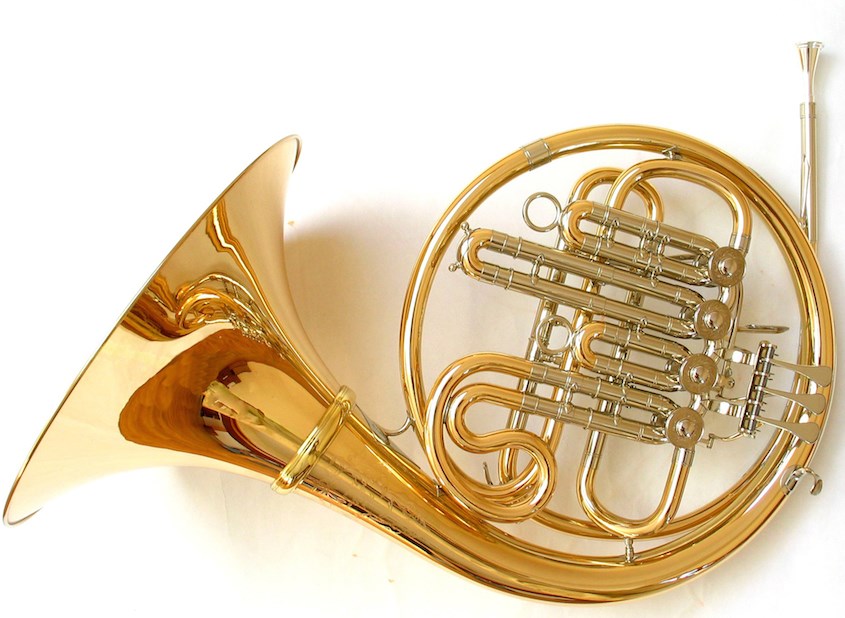
One of the most popular models of triple horn on the market is the Englebert Schmid. This is amongst the most expensive models of French Horn you can buy, but then if you’re thinking of getting a triple budget probably isn’t your primary consideration!
This horn is played by many professional players, including the former principal horn of the New York Philharmonic, Philip Meyers. Meyers claims to have never considered playing another horn after trying this instrument!
This horn costs around $20,000 depending on the exact specification you order. As these instruments are custom made, there can also be a waiting time of six months for delivery!
Features
- F/Bb/F alto or F/Bb/Eb alto options
- Adjustable slides mean that the horn can be raised or lowered by a semitone to aid tricky passages (for example the horn in E passages in Cosi Fan Tutte)
- Choice of metals
- Unique handmade design
- Adjustable tuning bit in the lead pipe
FAQs
Answer: The short answer is no. Double horns can help your accuracy in the high register more than a single F horn, but won’t actually help you play higher, sadly that’s all up to you and your practice regimen! To understand the long answer, it takes a little consideration of the physics behind playing brass instruments. When we play the horn without using open valves, we’re switching between different partials of the harmonic series (for a more thorough explanation of this, check out here).
The closer together the partials you’re on, the more difficult it is to hit the note you’re aiming for. You might imagine this as a piano keyboard in which the keys get thinner and thinner the higher you go!
As the Bb side of the horn is pitched a fourth higher than the F side, it means that the partials are a little bit less spread out. A top C (the second line above the staff) is just the 12th harmonic on the Bb side, but the 16th on the F side!
Although it can help, the physics behind this isn’t super important to understand. You need to know that a double horn can help the accuracy of your high notes but won’t play them for you!
Answer: Triple horns are more expensive than double horns because of the extra time and materials involved in creating the instrument. Where the double horn has two lengths of tubing, in F and Bb, the triple horn has an additional one in high Eb or F. This is a more complex construction involving more materials, so the price is adjusted accordingly.
Answer: You don’t necessarily need a triple horn. However, they can be a useful type of instrument, especially if you are a player regularly playing in the extreme high register while wanting to maintain the option of a full F side. If you’re a beginner player or play low horn parts so don’t regularly use the high register, a triple horn might be an unnecessary expense. Even professionally, the vast majority of players use a full double horn as their go-to horn, as it’s possible to play everything on it with as good a sound (if not better) than a triple horn.
If you play in a marching band, you definitely don’t need (or want) a triple horn. They’re heavy, expensive, and you are unlikely to see the benefits of this kind of instrument playing marching band repertoire outside.
Answer: This all depends on your budget! Triple horns are expensive equipment, and while a double horn will cost up to around £9000 new, a triple horn can cost upwards of £15000 new. If budget is an important consideration for buying a horn, then a triple horn isn’t worth the investment. However, if you play challenging music regularly enough to need one then they might be a good investment — especially if you can manage to find a great model second-hand in good condition.
Ultimately it’s all up to you, the repertoire you play, and your budget!



